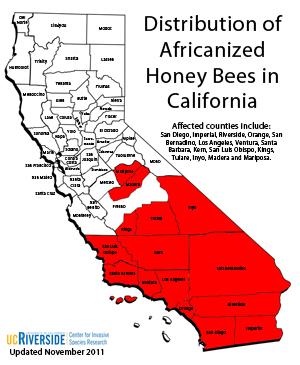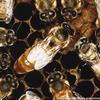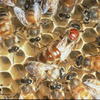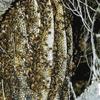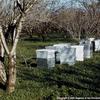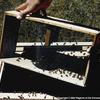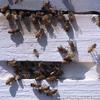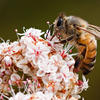Africanized Honey Bee, Apis mellifera
The Situation: Africanized honey bees are a hybrid between European and African bee subspecies which were inadvertently released in Brazil in the 1950s. They have spread to the south as far as northern Argentina and to the north into the United States, as well as throughout much of South and Central America. They entered Texas in 1990, Arizona and New Mexico in 1993, and California in 1994. European bees have long been established in much of the United States, including California. Following colonization, unmanaged bee populations are replaced or mixed with Africanized Honey Bee.
Damage: Immigration of africanized honey bee results in a greater density of highly defensive bee colonies. Africanized honey bee respond to activity near their colonies with increased numbers of stinging bees over much greater distances. This can make them life-threatening, especially to people allergic to stings or with limited capacity to escape (the young, old and handicapped), and to confined livestock or pets. In each country into which they have migrated, they have killed humans and animals. Beekeeping is also disrupted by africanized honey bees, which are more difficult to manage and transport. Maintaining colonies of European bees in areas with africanized honey bees is the best defense, but to do so beekeepers face greater expense, more difficulty finding sites for bees because of public fear, and greater liability concerns.
Economic Impact: The US has had effective public education and control practices, and few people have been or will be killed. If the state were fully colonized by africanized honey bees, bee and queen sales ($11 million) would end or be sharply reduced, resulting in reduced numbers of beekeepers and colonies which would lower honey and wax production ($42 million) as well as pollination rental income ($122 million). More significantly, the annual value added by honey bee pollination of agricultural crops in California in 2005 exceeded $3.9 billion; reductions in managed bee colonies have resulted in substantially increased costs and decreased yields in many fruit, nut, vegetable, and seed crops. Publicity about "killer bees" may also have minor impacts on tourism and outdoor activities.
Distribution: As of 2008 Africanized bees had colonized all southern California counties, and the southern Central Valley. Though Africanized Honey Bee spread has slowed, in time, their range may expand to much of coastal California and the Central Valley. These bees can be expected to thrive in urban, agricultural, and some recreational areas.
Research: The University of California has responded as follows: 1) Understanding how defensive behavior of honey bees is controlled (UCR) and the bees' genetics (UCD) will contribute to breeding programs to ameliorate the impact of africanized honey bees and to management techniques in pest control and beekeeping contexts; 2) control methods (UCR) have been developed to provide pest control personnel with means of safely removing swarms and established colonies of africanized honey bees; 3) studies of foraging behavior and pollination (UCR, UCD) will help maximize the effectiveness of honey bees and alternative pollinators; 4) detection techniques (UCD) aid in tracking africanized honey bee movement and certification of European bees; 5) public information (UCR, UCD, UC Extension) is also a critical component of minimizing the impact of africanized honey bees in California.
More Media on the the Africanized Honey Bee
UCR: Honey Bee Research at UCR
Utah Pests: Africanized Honey Bees, Fact Sheet (pdf)
Invasive.org Photos of Africanized Honey Bee
BugGuide.net Photos of Africanized Honey Bee
Center for Invasive Species Research
Text provided by Kirk Visscher, Associate Professor of Entomology at University of California Riverside
kirk.visscher@ucr.edu
Personal Website

